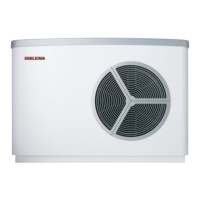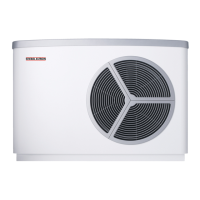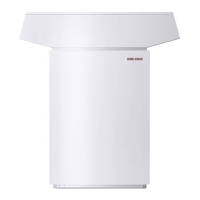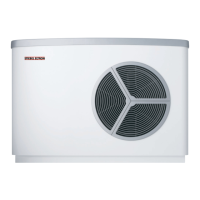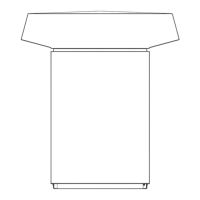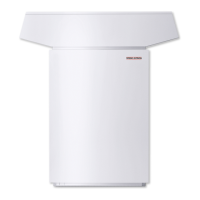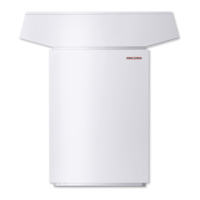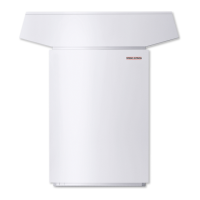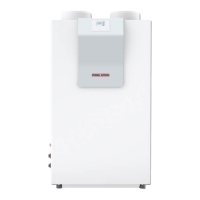5
Heat pump
Part no.
Type WPL 7 AS
22 20 49
WPL 7 IKS
22 21 38
WPL 10 AS
22 20 48
WPL 10 IKS
22 21 37
Design and operating mode compact compact compact compact
Design: compact / split / open version mono-mode
altn. dual-mode
parallel dual-mode
Dimensions, weights, connection dimensions
Dimensions
Weight
L/W/H
mm
kg
1122x967x1245
182
925x778x1668
212
1122x967x1245
182
925x778x1668
212
Refrigerant Type R 407C
Fill weight kg see type plate
Pipe connector – heating side (flow and return)
“/mm
G 1¼” (male) 22 plug-in conn. G 1¼” (male) 22 plug-in conn
Air hose connector (inlet and outlet connector) L/W mm hose Ø 315 hose Ø 315
Expansion vessel volume
primary pressure
l
MPa (bar)
12
0.15 (1.5)
12
0.15 (1.5)
Output
Heat output at A–7/W35
1)
at A2/W35
2)
kW
kW
3.2
4.9
3.2
4.9
5.4
6.7
5.4
6.7
Power consumption at A–7/W35
1)
at A2/W35
2)
kW
kW
1.2
1.5
1.2
1.5
1.8
2.1
1.8
2.1
Performance factor at A–7/W35
1)
at A2/W35
2)
2.6
3.3
2.6
3.3
2.9
2.3
2.9
2.3
Power consumption – booster heater kW 6.2 6.2 6.2 6.2
Process medium
Volume flow, hot side WNA nominal / min
4)
m³/h 1.07 / 0.4 1.07 / 0.4 1.04 / 0.5 1.04 / 0.5
Internal pressure differential hPa 110 110 110 110
Volume flow, cold side WQA min 3
3)
m³/h 1200 1200 1200 1200
Externally available static pressure differential (only for internal
version)
hPa – 1,0 – 1.0
Operating temperature limits
WQA min. / WQA max
3)
°C –20 (–10) [0] / +30 –20 (–10) / +30
WNA min. / WNA max
4)
°C +15 / +35 (+50) [+60] +15 / +50 (+60)
Electrical specification
Fuses:
Heat pump power supply (compressor)
Supply – booster heater DHC (internal HS 2)
Control circuit
A
A
A
20 gl
35 gl
16 gl
20 gl
35 gl
16 gl
20 gl
35 gl
16 gl
20 gl
35 gl
16 gl
Protection EN 60529 (DIN VDE 0470) IP 14 B IP 20 IP 14 B IP 20
Voltage / frequency – compressor V/Hz 1/N/PE~230/50 1/N/PE~230/50 1/N/PE~230/50 1/N/PE~230/50
Voltage / frequency – booster heater DHC (internal HS 2) V/Hz 1/N/PE~230/50 1/N/PE~230/50 1/N/PE~230/50 1/N/PE~230/50
Voltage / frequency – control circuit V/Hz 1/N/PE~230/50 1/N/PE~230/50 1/N/PE~230/50 1/N/PE~230/50
Starting current A < 35 < 35 < 43 < 43
Defrost
Time/demand/manual defrost demand / manual
Type of defrost: hot gas/electric/air/flow reversal flow reversal
Heating the drip pan yes, supercooler
Other model characteristics
Frost protection measures
yes/no
yes
Corrosion protection – frame and casing hot-dipped galv.
Compliant with safety regulations DIN EN 60335; DIN 8975,
EMC Directive 89/336/EEC,
Low Voltage Directive 73/23/EEC
Sound power level to DIN EN
255
Sound pressure level at 5 m
External installation Internal installation;
internal / external
dB(A)
dB(A)
dB(A)
65
–
43
–
57/62
35/41
65
–
43
–
57/62
35/41
1)
A–7/W35 = Air inlet temperature: -7 °C, heating flow: 35 °C
2)
A2/W35 = Air inlet temperature: 2 °C, heating flow: 35 °C
3)
WQA = Heat source system (cold side)
4)
WNA = Heat utilisation system (hot side)
2.3 Specification singlephase (equipment information)
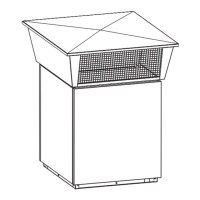
